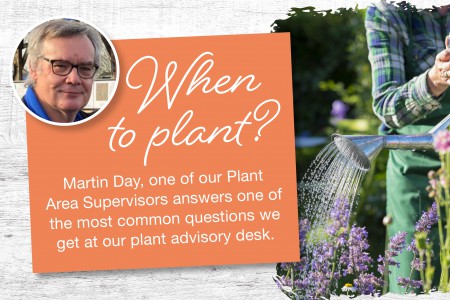When can I plant this ?
One of the most frequently asked questions we are asked in the Shrub/Outdoor plant section is “When can I plant this?” If the plant is in our outdoor sales area then it is hardy enough to be outside without being killed by cold weather, and would be happier planted in the ground than in its pot, so long as the ground isn’t frozen or waterlogged.
To give a bit of background, if you look at old gardening books, plants (with the exception of tender bedding plants) shrubs and trees used to be supplied as bare root plants when they were dormant. For example, once a deciduous fruit bush had dropped its leaves in the autumn, it could be dug up and stored ready for customers to plant out as soon as possible after collection or delivery. Plant pots were usually heavy and relatively fragile terracotta which didn’t transport well, especially by post. This meant that there was a fairly short season where they could be dug up, moved around then planted.
Only a few specialist nurseries use this system now, and as the winters have been milder the time to start digging the plants up has become later and later: this year the process typically started in mid-November. This changed significantly in the 1960s when the first containerised plants became available which had been grown on in pots rather than beds or fields. These plants could be sold for planting at any time of the year, which revolutionised garden centre sales. Some plants are still available as potted bare root plants – hedging and raspberry plants for example.
Growing plants in old fruit tins was an idea that first started in New Zealand and was brought back to this country in the 1960’s. Some of you may remember buying plants in this way and having the tins cut open at the tills! Once the advantages of this growing/selling method became realised plastic pots became available and became the most popular way plants are sold. Of course, over recent years the environmental impact of plastic pots has meant growers looking for ways to grow successfully whilst looking after the environment, currently we grow our crops in 100% recyclable blue or taupe pots which can be recycled along with other household plastics through kerbside collections in the St. Albans district.
There are a few things to consider when purchasing a potted plant: please don’t keep the plant in the container we sell it in for too long. High transport costs mean that they tend to be sold in a relatively small pot and that the roots will have used most of that space up. By planting them in the ground they will be able to spread their roots out and have a much larger area of soil to take water and nutrients from. Autumn and early winter are good times to plant as the soil is still warm, encouraging the roots to grow during the time when the plants need less water. Planting in the spring and summer is fine so long as the plants are given enough water: until the roots have moved out properly into the surrounding soil they will need quite a lot of water to keep them happy.
Don’t rely on the rain alone especially in the summer as we are in the driest part of the country! For a tree or shrub it is better to give it a couple of watering cans worth twice a week than a quick squirt with a hose every evening. If you need to use a hose, try timing how long it takes to fill a watering can from the hose – you will probably be surprised. The easiest way of checking if a plant needs extra water is to check the soil moisture around the root ball with your finger. It should feel moist but not sopping wet. Planted containers can be deceptive: even torrential rain won’t get past lush foliage so they will need regular careful checking (or an irrigation system installing). Hot, sunny and windy weather will mean that plants use water a lot more quickly than on a dull, still day so do check your plants more frequently during weather that will dry them out quickly. You will often see the Plant Area Team giving the plants extra water by hand during hot, windy days, as the plants use water at a much greater rate than on a cooler day.
For further advice on planting, see our Planting Instructions Leaflet which covers soil preparation (including the need for ericaceous compost for certain plants) planting depth, watering and mulching requirements, as well as listing some plants which are on the tender side and need either a sheltered spot or winter protection from bad weather. The only things I would add are to consider using a product such as Rootgrow which is a mycorrhizal fungus which helps the roots absorb water and nutrients.


